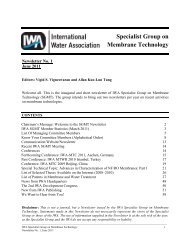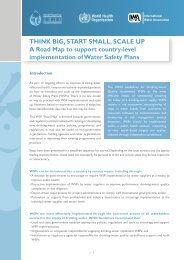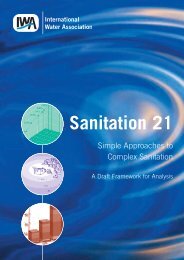Specialist Group on ANAEROBIC DIGESTION Newsletter - IWA
Specialist Group on ANAEROBIC DIGESTION Newsletter - IWA
Specialist Group on ANAEROBIC DIGESTION Newsletter - IWA
Create successful ePaper yourself
Turn your PDF publications into a flip-book with our unique Google optimized e-Paper software.
Bioaugmentati<strong>on</strong> for recovery of anaerobic digesters subjected to a toxicant<br />
by Anne E. Schauer-Giménez<br />
Instituti<strong>on</strong>:<br />
Marquette University, December 2008<br />
New PhD C<strong>on</strong>tact:<br />
Post-doctoral Fellow<br />
Marquette University<br />
Water Quality Center<br />
Milwaukee, WI (USA)<br />
Supervisor:<br />
Dr. Daniel H. Zitome<br />
Abstract:<br />
Traditi<strong>on</strong>ally, practiti<strong>on</strong>ers have c<strong>on</strong>sidered anaerobic methanogenic cultures as “black boxes” and have not paid<br />
c<strong>on</strong>siderable attenti<strong>on</strong> to the microorganisms. However, the methanogenic community is important because<br />
different populati<strong>on</strong>s may behave differently in terms of methane producti<strong>on</strong> rate or stability during process<br />
upset. The research presented in this dissertati<strong>on</strong> explored the diversity of Bacteria and Archaea communities in<br />
various methanogenic enrichment cultures.<br />
With the help of molecular techniques (PCR, cl<strong>on</strong>ing, restricti<strong>on</strong> digests, and sequencing), Bacteria and<br />
Archaea cl<strong>on</strong>e libraries were c<strong>on</strong>structed for four enrichment cultures herein referred to as C1, C2, C3, C4. The<br />
enrichment c<strong>on</strong>diti<strong>on</strong>s differed based up<strong>on</strong> substrates and oxygen fed, and were as follows: C1 – H 2 :CO 2 , C2 –<br />
H 2 :CO 2 + glucose, C3 – H 2 :CO 2 + air, and C4 – H 2 :CO 2 + glucose and air. It was hypothesized that the varied<br />
c<strong>on</strong>diti<strong>on</strong>s would have an effect <strong>on</strong> microbial community diversity.<br />
When comparing the enrichment cultures that received air versus those that did not, a shift in methanogen<br />
community occurred. In C1 and C2, Methanosaeta was the most dominant genus. On the other hand,<br />
Methanosaeta was not dominant in C4 and not found in any sequences in C3. Methanospirillum was the most<br />
comm<strong>on</strong> methanogen genus in C3. These results indicate that additi<strong>on</strong> of air had an effect <strong>on</strong> the methanogen<br />
community.<br />
Bioaugmentati<strong>on</strong>, the additi<strong>on</strong> of a specific microorganism or mixed culture to enhance a desired activity<br />
(e.g. methane producti<strong>on</strong> or COD reducti<strong>on</strong>), can potentially be used to increase the recovery rate of anaerobic<br />
wastewater treatment facilities after exposure to toxicants. In the work describe herein, cultures C2 and C4 were<br />
used to bioaugment upset anaerobic digesters. The bioaugmentati<strong>on</strong> investigati<strong>on</strong>s successfully dem<strong>on</strong>strated<br />
the ability of the bioaugmentati<strong>on</strong> culture to increase methane producti<strong>on</strong> and recovery rate of a stressed digester<br />
exposed to the toxicant, oxygen. Methane producti<strong>on</strong> increased an average of 47% in the bioaugmentati<strong>on</strong><br />
digesters as compared to the c<strong>on</strong>trols, which were not bioaugmented. Also, SCOD c<strong>on</strong>centrati<strong>on</strong>s in the<br />
bioaugmented digesters decreased below 2,000 mg/L 83 days so<strong>on</strong>er than the c<strong>on</strong>trols. Bioaugmentati<strong>on</strong> is a<br />
promising approach to help decrease the recovery time of anaerobic digesters exposed to a toxicant.<br />
<strong>IWA</strong> <str<strong>on</strong>g>Specialist</str<strong>on</strong>g> <str<strong>on</strong>g>Group</str<strong>on</strong>g> <strong>on</strong> Anaerobic Digesti<strong>on</strong><br />
26 June 2009 <strong>Newsletter</strong>

















